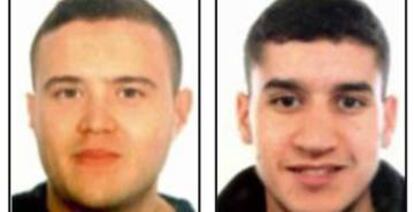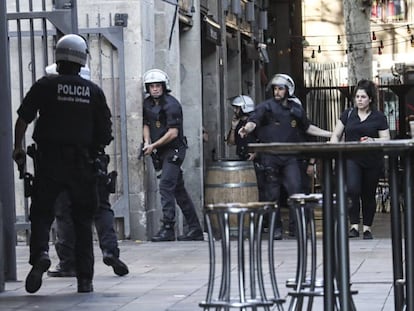What we know so far about the Catalonia terrorist attacks
Terror cell composed of 12 men based in Catalan town of Ripoll thought to be behind attacks in Barcelona and Cambrils that have left 14 dead and over 130 injured

Please note: this story is no longer being updated.
At 4.50pm on Thursday a van smashed into a crowd of people on the central pedestrian area of the busy La Rambla promenade in Barcelona, traveling 530 meters before stopping.
A total of 13 people were killed, and more than 130 others were injured. Four Spanish victims have been confirmed as dead to date, while there are people from at least 35 nationalities among the dead and the injured. This group includes children.

At 1.15am on Friday morning a vehicle with five terror suspects plowed into various people in Cambrils, a resort town in Tarragona province. One victim of this attack died and five others were injured, three of them officers with the Mossos d’Esquadra.
Regional police then killed the five suspected terrorists, all of whom were wearing explosive vests later revealed to be false.
The so-called Islamic State (ISIS) late on Friday claimed responsibility for the Barcelona attack via the Amaq news outlet, which is affiliated with the terrorist organization.
Catalan regional police believe a terrorist cell comprised of 12 men, all of them either Moroccan or of Moroccan origin, and all of them based in the Catalan town of Ripoll, were behind the two attacks. Spain's Interior Ministry now believe this cell has been dismantled. However Catalan authorities have noted that “two or three” arrests remain to be made.
Police are investigating the possibility that the men who formed this cell were radicalized by Ripoll-based imam Abdelbaki Es Satty. His house was searched for evidence by police on Saturday morning.
Meanwhile, the driver of the van used in the Barcelona attack is still be being sought by police. The chief suspect as of late Friday was 22-year-old Younes Abouyaaqoub. Abouyaaqoub is a resident of the Catalan town of Ripoll, in Catalonia’s Girona province.

Initially police had named Mousa Oukabir, 17, as the possible driver of the van used in the Barcelona attack: authorities have not ruled him out as the driver, but he is no longer the chief suspect.
Mousa Oukabir's Moroccan-born brother, Driss Oukabir, who allegedly rented the van used in the La Rambla attack, was arrested in Ripoll on Thursday. His ID was found in the van used in that attack. However, he claims his brother stole his documents.
A second van was found in the Catalan city of Vic, also allegedly hired by Driss Oukabir.
On Thursday, Catalonia’s regional police, the Mossos d’Esquadra, revealed that an explosion in the Catalan town of Alcanar late on Wednesday was believed to be linked to the attack in Barcelona.
One man injured in that blast, Mohamed Houli Chemlal, was arrested. He is now recovering and has been key to the investigations into the Catalonia attacks.
Authorities now believe the residents of the house in Alcanar were planning a large attack involving explosive devices, but that this attack was fortunately averted by the accidental explosion on Wednesday. Traces of the explosive acetone peroxide (TATP) were found at the scene.
Biological traces of at least three victims have been found in the property, according to anti-terrorism sources. That group of three does not include the man injured and arrested in Alcanar.
One of the people who died in the explosion may be the imam suspected of having radicalized the cell behind the Barcelona and Cambrils attacks.
The identity of the five terror suspects killed in Cambrils has been confirmed: they are Mousa Oukabir, Said Aallaa, Mohamed Hychami, Omar Hychami and Houssaine Abouyaaqoub. Police said the identification of Mousa Oukabir was based on fingerprints.
Two other arrests have been in the town of Ripoll, bringing the total number of detentions in relation to the attacks in Barcelona and Cambrils to four. Three of those detained are Moroccan nationals and one in Spanish. None of the four men arrested has previous convictions for terrorism offenses.
English version by George Mills.
Tu suscripción se está usando en otro dispositivo
¿Quieres añadir otro usuario a tu suscripción?
Si continúas leyendo en este dispositivo, no se podrá leer en el otro.
FlechaTu suscripción se está usando en otro dispositivo y solo puedes acceder a EL PAÍS desde un dispositivo a la vez.
Si quieres compartir tu cuenta, cambia tu suscripción a la modalidad Premium, así podrás añadir otro usuario. Cada uno accederá con su propia cuenta de email, lo que os permitirá personalizar vuestra experiencia en EL PAÍS.
¿Tienes una suscripción de empresa? Accede aquí para contratar más cuentas.
En el caso de no saber quién está usando tu cuenta, te recomendamos cambiar tu contraseña aquí.
Si decides continuar compartiendo tu cuenta, este mensaje se mostrará en tu dispositivo y en el de la otra persona que está usando tu cuenta de forma indefinida, afectando a tu experiencia de lectura. Puedes consultar aquí los términos y condiciones de la suscripción digital.
More information
Archived In
Últimas noticias
Most viewed
- Gilles Lipovetsky: ‘If you want to live better and fall in love, take Prozac, don’t look to philosophy’
- Alain Aspect, Nobel laureate in physics: ‘Einstein was so smart that he would have had to recognize quantum entanglement’
- Maduro’s downfall puts China’s relationship with Venezuela to the test
- Why oil has been at the center of Venezuela-US conflicts for decades
- The US bombing of Venezuela, in pictures










































